![[Image]](48th.jpg)
Contributed by Steven Cone
Regiments and Their Flags
Units and the Flags that some of our Cone members served under.
ALABAMA
48 Alabama Infantry.
This flag an Army of Northern Virginia, 6th wool bunting issue. It was manufactured at the Richmond Depot during the winter of 1864-65. The flag was apparently surrendered at Appomattox and eventually forwarded to the U.S. War Department in Washington. There, it was assigned Capture Number 392 and described as "Battle-flag of the forty-eight Alabama, Fields Division, Longstreets' corps." The flag was returned to the State of Alabama effective March 25, 1905
![[Image]](48th.jpg)
38th Alabama Infantry
Flags of this pattern were manufactured in Mobile, Alabama, and issued within the Department of Alabama, Mississippi and East Louisiana1. This flag was issued to the regiment sometime after the Battle of Rocky Face Ridge (February 25, 1864), which is the last battle honor listed on the flag. This flag was captured at the Battle of Resaca, Georgia on May 15, 1864 by Captain Thomas J. Box of Company D, 27th Indiana Volunteers. Captain Box was recommended for and received the Congressional Medal of Honor. The flag was eventually forwarded to the War Department where it was assigned War Department Capture Number 232. It was returned to the State of Alabama effective March 25, 1905.
This flag is one of four nearly identical flags in the Department's collection which were carried by regiments within the brigade of Brigadier General H. D. Clayton at the Battle of Resaca, Georgia.
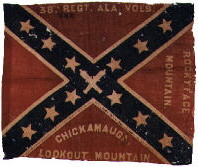
38th Ala Infantry
This flag conforms to the pattern of those issued to the corps of Major General William J. Hardee, Army of the Mississippi/Army of Tennessee. It was manufactured in July 1863 and was captured on November 25, 1863 during the Battle of Missionary Ridge by the 2nd Ohio Volunteer Infantry, Colonel H. G. McCook commanding. The flag was eventually forwarded to the U.S. War Department where it was assigned Capture Number 91. The flag and its staff were returned to the State of Alabama effective March 25, 1905. While a portion of the broken staff remained in the pole sleeve of the flag, the remainder had become separated. In July, 1998, the missing portion of the staff was located and positively identified
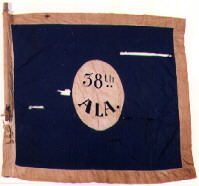
26 (O'Neal's) Alabama Infantry.
This flag is an Army of Northern Virginia, 3rd wool bunting issue. Flags of this issue were manufactured at the Richmond Depot between July 1862 and May 1864. On April 20, 1863, Colonel Edward Asbury O'Neal, 26th Alabama Infantry forwarded the regiment's old battle flag to the Governor of Alabama stating "The Government having issued to this Regiment a new flag, we respectfully ask that the old one may be deposited in the Archives of the State." Their new flag was captured on July 1, 1863 at Gettysburg, Pennsylvania. This flag was issued to the regiment after the Gettysburg campaign and carried by them for the remainder of the war.
Following the surrender of the 26th Alabama Infantry at Greensboro, North Carolina in April 1865 the servant of Dr. Hayes, Brigade Surgeon wrapped the flag around his body and slipped through the Federal lines, thus saving the flag. How long the flag remained with Dr. Hayes is unknown, however, by September 21, 1900, it was in the possession of O'Neal's wife.

28th Alabama Infantry Flag
Captured; Orchard Knob,
Battle of Chattanooga Nov. 23, 1863

Florida
2nd Regiment Florida Volunteer Infantry
Bears unit designation: 2nd FLORIDA
Battle honors (faded, appear to be):
WILLIAMSBURG, SEVEN PINES, ELLISON'S MILLS ,FRASIER'S FARM, SHARPSBURG, GETTYSBURG, CHANCELORSVILLE, BRANDY STA., (illegible honor: GAINES' FARM)
Not captured; retired from service and sent to the Governor of Florida in early 1865.

5 Florida Infantry (Confederate.)
Bears unit designation: 5 FLORIDA, No battle honors. Not captured.
This flag was carried in the Battle of Gettysburg and was retired several months later.
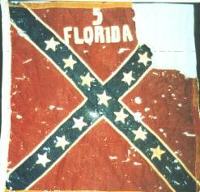
Georgia
8th Georgia Infantry
8th Georgia Regimental "Second Bunting" flag, with orange borders. These were issued in 1862, 48 inches square, made by the Richmond Clothing Depot. The flag was carried back to Rome after the Appomattox surrender in Lt. Col. E. J. Magruder's boot, and is believed to be the one now in possession of Mr. Towers, descendant of the 8th's Colonel, John R. Towers.
9th Georgia Infantry
The Regimental battle flag accompanied the Ninth Georgia in about 60 engagements, from minor skirmishes to major battles, and was never captured or surrendered. The surviving flag was replaced by a new one on 25 Mar.,1865, and sent to Col. Edward Hoge's sisters, Lizzie and Katie, who originally presented it. They, in turn, donated the 9th's flag to the State of Georgia on 20 July, 1910. The flag surrendered at Appomattox on 9 April, 1865 was the new replacement flag, not the original. This flag is in the Capitol Collection in Atlanta, Ga.
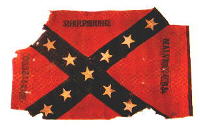
Illinois
19 Illinois Infantry
This flag is inscribed:"Presented by the Citizens of Chicago." It measures 70" on the staff by 72" on the fly.
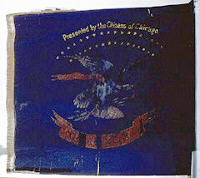
23 Illinois Infantry "Irish Brigade"
The 23rd Illinois Infantry was also known as the Irish Brigade or the 1st Irish Regiment. The Regimental guidon or flank marker reflects this Irish influence. This color measures approximately 30" x 20".

3rd Illinois Cavalry Guidon
The men of the 3rd Cavalry served from Sangamon (Morgan's Escort), Tazewell, Cass, Bond (Steele's Escort), Saline, Adams, Brown, Fulton, Livingston, Macoupin and McClean (McClernand's Escort) and Christian Counties
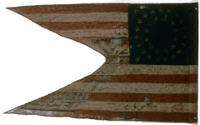
3rd Illinois Cavalry
Although the pattern of this flag is similar to that of the Regimental flag of the Infantry, by definition it is called the Cavalry "Standard."
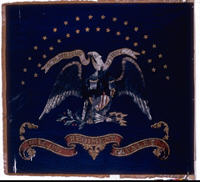
Michigan
6th Michigan Cavalry
Organized at Grand Rapids and sent to the field 11 October 1862, the Sixth Michigan flew this flag. It bears the motto "Fear Not Death--Fear Dishonor."

6th Michigan Cavalry " George A. Custer"
The Sixth Michigan Cavalry Regiment was organized in Grand Rapids and sent to the field in October of 1862. Along with the First, Fifth, and Seventh, it was part of the Michigan Cavalry Brigade commanded by General George Custer.
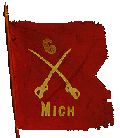
Texas
1st. Texas Infantry
This flag was found with the First Texas Lone Star Flag in the cornfield at Sharpsburg. It features a tear that was repaired with a woven lock of hair from a Union Zouave killed during the Battle of Second Manassas. It is made of cotton and was designed to replace previous editions made of silk that were too fragile for field use. This flag is currently undergoing conservation.

This Texas Flag was carried by the 1st Texas Infantry into the Cornfield at Sharpsburg. After 20 minutes of savage fighting, 82.3% of the regiment was dead or wounded, the highest casualty rate suffered by any unit during the war. After seven color bearers were killed carrying the flag, it was found on the field after the battle, surrounded by dead Texans. Returned to Texas by the Federal Government in 1905, it is currently undergoing conservation.
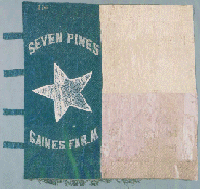
If you'd like to email us comments or even better, to add your sources to the site, please do by emailing them!